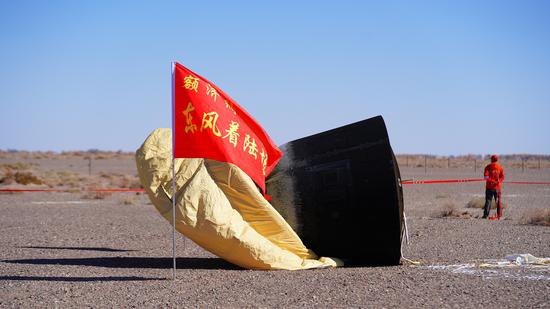
China's first reusable satellite returns to Earth with payloads on Oct. 11, 2024. (Photo provided to chinadaily.com.cn) Articles such as seeds, microorganisms delivered to Chinese, foreign officials Scientific payloads returned from the maiden flight of China's first reusable satellite were delivered to their owners on Thursday. At a handover ceremony held by the China National Space Administration at its Beijing headquarters, the CNSA delivered payloads to governmental departments and officials, including authorities from the provinces of Hainan and Anhui and the Ministry of Agriculture and Rural Affairs. It also handed over payloads to foreign officials from countries such as Thailand and Pakistan. Meanwhile, China Aerospace Science and Technology Corp, the nation's leading space contractor and the satellite's maker, delivered commercial goods to domestic enterprises. The articles delivered on Thursday arrived after a 13.5-day flight with Shijian 19, the first Chinese recoverable satellite that can be reused. Previously, China had launched nearly 30 recoverable satellites, but none of them could be reused. Developed by the China Academy of Space Technology in Beijing, Shijian 19 was taken into space by a Long March 2D carrier rocket that lifted off on Sept 27 from the Jiuquan Satellite Launch Center in the Inner Mongolia autonomous region. It was tasked with servicing space-based mutation breeding programs and carrying out flight tests for the research of domestically developed materials and electronic components. There were 20 categories of payloads flown with the satellite, including plant seeds, microorganism samples, technology demonstration devices, space experimental instruments and cultural items. The spacecraft returned to Earth on Oct 11 and was recovered at its predetermined landing site in Inner Mongolia. Bian Zhigang, deputy head of the space administration, said at the ceremony that breeding experiments of about 1,000 species of germplasm resources were conducted aboard Shijian 19, providing crucial support for the innovation of germplasm resources in China. The mission also offered a valuable in-orbit validation opportunity for domestically produced components and raw materials, he noted. Zhao Huiguang, a senior researcher with China Aerospace Science and Technology Corp, said after the ceremony that the satellite's designers developed new equipment for it to better withstand extreme heat during atmospheric reentry and to mitigate the landing impact. He said reusable satellites enable scientists to carry out demanding, time-sensitive experiments in orbit. "There are high levels of microgravity inside the spacecraft that are perfect for experiments requiring such conditions," he said. "In addition, a reusable satellite promises the rapid return of experimental samples to scientists as they conduct time-sensitive studies." The researcher noted that Shijian 19 is characterized by its good operational efficiency, as it is able to take a lot of payloads into space and then bring them back. Zhao said engineers will soon start checking the satellite's condition and replacing some equipment if needed. "The satellite has been designed to be used at least 10 times. It usually takes about six months for it to get ready for a flight, but normally the payloads will need more time for ground preparation," he said. |